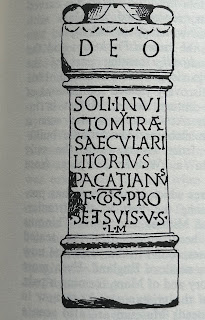Francis Wolle (1889-1979) was the pioneering scholar of Fitz-James O’Brien (1826?-1862). His 1933 Ph.D. thesis (Columbia) was the basis for his only book,
Fitz-James O’Brien: A Literary Bohemian of the Eighteen-Fifties (1944), an impressively-researched consideration of O’Brien and his writings, most of which had been published anonymously. Wolle’s work was the basis for Jessica Amanda Salmonson’s selection of O’Brien’s stories in her two volume set
The Supernatural Tales of Fitz-James O’Brien (1988), republished in one volume in 2008. Wayne R. Kime (b. 1941) expanded O’Brien’s bibliography considerably in his “Checklist of Fitz-James O’Brien’s Published Writings, 1852-1864,” included as an appendix to his edition of
Fitz-James O’Brien: Selected Literary Journalism, 1852-1860 (2003). Despite some extensive research, both Wolle’s and Kime’s listings have many problems, and modern research tools have proven a number of instances where they have wrongly attributed some story to O’Brien when it can demonstrably be shown to have been written by someone else. Perhaps the most egregious example of this is Kime’s
Thirteen Stories by Fitz-James O’Brien: The Realm of the Mind (2012), in which five of the thirteen stories are not by O’Brien. (Kime’s 2011 collection,
Behind the Curtain: Selected Fiction of Fitz-James O’Brien, 1853-1860, fares better, as it contains one misattributed story.) Even the recent three-volume edition of O’Brien’s fiction from Swan River Press, edited by John P. Irish, contains at least one story not by O’Brien (with a few more under research).
Of course O’Brien published no collection of his stories during his short lifetime, so it is interesting to see in Wolle’s book the description of a table of contents made by O’Brien himself for a proposed collection. Wolle notes that at the time of his research, the manuscript of the contents listing was owned by Albert F. Goldsmith, a bookseller of New York City. Where it may be now is not known.
Here follows a transcription of the listing of twenty stories, to which I have added the year of publication (in parentheses), and asterisks to ten tales (the reason is described below):
“The Diamond Lens and other tales By Fitz James O’Brien”
*The Diamond Lens (1858)
*Duke Humphrey’s Dinner (1855)
*The Golden Ingot (1858)
*The Pot of Tulips (1855)
*The Lost Room (1858)
Three of a Trade (1858)
*My Wife’s Tempter (1857)
Jubal the Ringer (1858)
Belladonna (1854)
Hard Up (1854)
Mrs. Macsimum’s Bill (1854)
*Mother of Pearl (1860)
*The Bohemian (1855)
*The Dragon Fang Possessed by the Conjurer Piou Lou (1856)
*The Wondersmith (1859)
Bird Gossip (1855)
Lost (1857 or 1858)
One Event (1852)
Carrying Weight (1852)
The King of Nodland and his Dwarf (1852)
Wolle notes: "In front of each of the last four titles is a small circle, which might indicate that he preferred not to include them, 'Lost' I have not been able to locate. 'Amy Scudder,' the title of a poem, is written in much lighter at the end, and after 'other tales' of the heading, is written in '. . .& poems' (p. 230-231).
Wolle suggests that the listing dates from late 1861, but I would question that for two reasons, The first is that the latest item on the list, "Mother of Pearl," was published in February 1860. And the second reason is that it leaves off one of O'Brien's best tales, "What Was It?" published in March 1859. (We have no dates of composition for his stories to help us judge here.)
The first O’Brien collection, The Poems and Stories of Fitz-James O'Brien (1881), was put together by William Winter and others of O'Brien's friends. Winter’s volume includes ten stories from the above list, plus three
additional ones ("Tommatoo", "Milly Dove", "What Was It?). Most of the remaining stories are familiar from later O'Brien collections, but Wolle didn't know of the story "Lost." Kime found two anonymous stories of this title, both of which he ascribes to O'Brien.* "Lost: The Story of Four Young Men," in Harper's New Monthly Magazine for November 1857, Kime describes as recounting "the decline and death of an amiable and multitalented young man who has squandered his natural gifts" (Behind the Curtain, p. 191, n. 1). The second story is titled simply "Lost" and it appeared in The New York Tribune, 9 October 1858. It is the story of a young girl who gets lost in New York and the poor old woman who pretends to help her steals her money and fineries. If O'Brien meant either of these stories, it is unclear. The other outlier on this list is "Bird Gossip" which is an essay (on birds, an interest of O'Brien's), which Wolle describes as "a rambling essay of miscellaneous information about birds" (p. 10).
Of course an author is rarely the best judge of their own writings, and we are left viewing O'Brien's list of titles merely as a diverting what-if.
* I note that the Index to Harper's New Monthly Magazine: volumes I to LX, from June 1850 to June 1880 (1881), compiled by Charles A. Durfee, ascribes the November 1857 story to John Esten Cooke, and see no reason to disagree with it.


